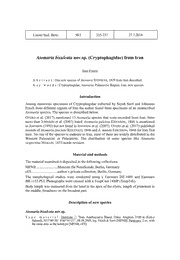
Atomaria bisulcata nov.sp. (Cryptophagidae) from Iran PDF
Preview Atomaria bisulcata nov.sp. (Cryptophagidae) from Iran
Linzer biol. Beitr. 50/1 235-237 27.7.2018 Atomaria bisulcata nov.sp. (Cryptophagidae) from Iran Jens ESSER A bstract: One new species of Atomaria STEPHENS, 1829 from Iran described. K ey w ords: Cryptophagidae, Atomaria, Palaearctic Region, Iran, new species. Introduction Among numerous specimens of Cryptophagidae collected by Sayeh Serri and Johannes Frisch from different regions of Iran the author found three specimens of an undescribed Atomaria species. The species is drescribed below. OTERO et al. (2017) mentioned 13 Atomaria species that were recorded from Iran, three more than JOHNSON et al. (2007) listed. Atomaria pulchra ERICHSON, 1846 is mentioned in JOHNSON (1993) but not listed in JOHNSON et al. (2007). OTERO et al. (2017) published records of Atomaria fasciata KOLENATI, 1846 and A. munda ERICHSON, 1846 for Iran first time. No one of the species is endemic to Iran, most of them are widely distributed in the Western Palaearctic or Palaearctic. The distribution of some species like Atomaria vespertina MÄKLIN, 1853 needs revision. Material and methods The material examined is deposited in the following collections: MFNB ........................ Museum für Naturkunde, Berlin, Germany cES............................. author´s private collection, Berlin, Germany The morphological studies were conducted using a Euromex DZ-1605 and Euromex BB.1153.PLI. Photographs were created with a ToupCam 14MP (ToupTek). Body length was measured from the head to the apex of the elytra, length of pronotum in the middle, broadness on the broadest part. Description of new species Atomaria bisulcata nov.sp. T ype material: Holotype ♂: "Iran, Azarbayian-e Sharqi, Osku: Amghan, 2100 m (Kuh-e Sahand), N37°49‘38‘‘ E46°16‘15‘‘, 08.08.2005, leg. Frisch & Serri [MFNB]. Paratypes: 2 ex. with the same data as the holotype [MFNB, cES]. 236 E t y mol o gy : The Latin word bisulcata means split due to the parameres which has a deep split. Descr i pt i on: Male, 1,4 mm, hindwings absent, uniformly dark reddish-brown. Body stout and convex, with coarse and dense puncture, the distance of puncture on pronotum (disc) and elytra (anterior third) like the diameter. Covered with short yellowish pubescence (fig. 1). Anterior part of margin of the pronotum not visible from above, medium part of the basis moderately depressed. Sides moderately angled before the middle. Posterior angles nearly rectangular. Elytra oviform, puncture in the posterior third less coarse. Antennae slender, club 3-segmented but not well developed. Segments 9, 10 and 11 elongated, segments 3 to 8 decreasing in length but increasing in width. Segment longer and wider than 3, segment 1 longer and wider than 2 and slightly curved. Legs slender, all tarsi 5-segmented, anterior tarsi in male inconspicuous widened. Aedoeagus with a paramere with a deep split (fig. 2). Co m men t : More or less similar to a few species like A. fuscata (SCHÖNHERR, 1808) or A. gibbula ERICHSON, 1846 but separated by the parameres (fig. 2). Di st r i b u t i o n : Currently known from the type locality in Iran. Acknowledgement I wish to thank the staff (Johannes Frisch, Bernd Jaeger, Manfred Uhlig and Joachim Willers) of the Museum für Naturkunde, Berlin for loaning specimens and supporting my work. Zusammenfassung Eine Art der Gattung Atomaria STEPHENS, 1829 aus dem Iran wird beschrieben und mit ähnlichen Arten verglichen. References JOHNSON C. (1993): Provisional atlas of the Cryptophagidae-Atomariinae (Coleoptera) of Britain and Ireland. — Biological Records Centre, Huntingdon. JOHNSON C., OTERO J.C. & R.A.B. LESCHEN (2007): Cryptophagidae. — In: LÖBL I. & A. SMETANA, Catalogue of Palaearctic Coleoptera Vol. 4. Apollo Books, Stentrup: 513-531. OTERO J.C., GHAHARI H. & F. ANGELINI (2017): Contribution to the knowledge of Cryptophagids (Coleoptera Cryptophagidae) from Iran. — Redia 100: 45-51. Author´s address: Jens ESSER Fagottstraße 6 D-13127 Berlin, Germany E-mail: [email protected] 237 1 2 Fig. 1-2: (1) Atomaria bisulcata nov.sp., holotype, habitus; (2) aedoeagus.
